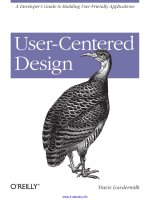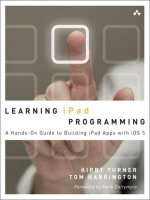learning android game programming a hands on guide to building your first android game rogers 2011 12 11 Lập trình android
Bạn đang xem bản rút gọn của tài liệu. Xem và tải ngay bản đầy đủ của tài liệu tại đây (11.44 MB, 476 trang )
Learning
Android Game
Programming
CuuDuongThanCong.com
Addison-Wesley Learning Series
Visit informit.com/learningseries for a complete list of available publications.
The Addison-Wesley Learning Series is a collection of hands-on programming
guides that help you quickly learn a new technology or language so you can
apply what you’ve learned right away.
Each title comes with sample code for the application or applications built in
the text. This code is fully annotated and can be reused in your own projects
with no strings attached. Many chapters end with a series of exercises to
encourage you to reexamine what you have just learned, and to tweak or
adjust the code as a way of learning.
Titles in this series take a simple approach: they get you going right away and
leave you with the ability to walk off and build your own application and apply
the language or technology to whatever you are working on.
CuuDuongThanCong.com
ries
Learning
Android Game
Programming
A Hands-On Guide to Building
Your First Android Game
blications.
Rick Rogers
Upper Saddle River, NJ • Boston • Indianapolis • San Francisco
New York • Toronto • Montreal • London • Munich • Paris • Madrid
Capetown • Sydney • Tokyo • Singapore • Mexico City
CuuDuongThanCong.com
Many of the designations used by manufacturers and sellers to distinguish their products
are claimed as trademarks. Where those designations appear in this book, and the
publisher was aware of a trademark claim, the designations have been printed with initial
capital letters or in all capitals.
The author and publisher have taken care in the preparation of this book, but make no
expressed or implied warranty of any kind and assume no responsibility for errors or
omissions. No liability is assumed for incidental or consequential damages in connection
with or arising out of the use of the information or programs contained herein.
The publisher offers excellent discounts on this book when ordered in quantity for bulk
purchases or special sales, which may include electronic versions and/or custom covers
and content particular to your business, training goals, marketing focus, and branding
interests. For more information, please contact:
U.S. Corporate and Government Sales
(800) 382-3419
For sales outside the United States, please contact:
International Sales
Visit us on the Web: informit.com/aw
Library of Congress Cataloging-in-Publication data is on file.
Copyright © 2012 Pearson Education, Inc.
All rights reserved. Printed in the United States of America. This publication is protected
by copyright, and permission must be obtained from the publisher prior to any prohibited
reproduction, storage in a retrieval system, or transmission in any form or by any means,
electronic, mechanical, photocopying, recording, or likewise. To obtain permission to use
material from this work, please submit a written request to Pearson Education, Inc.,
Permissions Department, One Lake Street, Upper Saddle River, New Jersey 07458,
or you may fax your request to (201) 236-3290.
ISBN-13:978-0-321-76962-6
ISBN-10:
0-321-76962-7
Text printed in the United States on recycled paper at RR Donnelley in
Crawfordsville, Indiana.
First printing, December 2011
CuuDuongThanCong.com
Editor-in-Chief
Mark L. Taub
Acquisitions Editor
Trina MacDonald
Development Editor
Songlin Qiu
Managing Editor
John Fuller
Full-Service
Production
Manager
Julie B. Nahil
Copy Editor
Jill E. Hobbs
Indexer
Ted Laux
Proofreader
Rebecca Rider
Technical Reviewers
James Becwar
Stephan Branczyk
Jason Wei
Cover Designer
Chuti Prasertsith
Compositor
LaurelTech
v
For Susie, my muse and my partner
“Let us be grateful to people who make us happy, they are
the charming gardeners who make our souls blossom.”
—Marcel Proust
v
CuuDuongThanCong.com
This page intentionally left blank
CuuDuongThanCong.com
Contents at a Glance
Foreword xix
Preface xxi
Acknowledgments xxiii
About the Author xxv
1 Mobile Games 1
2 Game Elements and Tools 15
3 The Game Loop and Menus 33
4 Scenes, Layers, Transitions, and Modifiers 53
5 Drawing and Sprites 87
6 Animation 109
7 Text 129
8 User Input 149
9 Tile Maps 173
10 Particle Systems 199
11 Sound 219
12 Physics 243
13 Artificial Intelligence 279
14 Scoring and Collisions 299
15 Multimedia Extensions 325
16 Game Integration 347
17 Testing and Publishing 365
A Exercise Solutions 381
Index 429
CuuDuongThanCong.com
This page intentionally left blank
CuuDuongThanCong.com
Contents
Foreword xix
Preface xxi
Acknowledgments xxiii
About the Author xxv
1 Mobile Games 1
The Mobile Game Market 1
The World of Computer Games 2
Game Genres 2
Games for Mobile Phones 4
Components of a Typical Game 5
Virgins Versus Vampires 7
Design of V3 8
AndEngine Examples 10
Summary 12
Exercises 12
2 Game Elements and Tools 15
Software Development Tools 15
Android Software Development Kit 16
AndEngine Game Engine Library 17
AndEngine Game Concepts 18
Box2D Physics Engine 19
Graphics Tools 20
Vector Graphics: Inkscape 20
Bitmap Graphics: GIMP 22
Animation Capture: AnimGet 22
TileMap Creation: Tiled 23
TrueType Font Creation and Editing: FontStruct 24
Audio Tools 24
Sound Effects: Audacity 25
Background Music: MuseScore 25
CuuDuongThanCong.com
x
Contents
Getting Our Feet Wet: The Splash Screen 26
Creating the Game Project 26
Adding the AndEngine Library 27
Adding the Splash Screen Code 28
Running the Game in the Emulator 31
Running the Game on an Android Device 31
Summary 31
Exercises 32
3 The Game Loop and Menus 33
Game Loops in General 33
The Game Loop in AndEngine 34
Engine Initialization 35
Other Engines 36
Adding a Menu Screen to V3 37
Menus in AndEngine 37
Building the V3 Opening Menu 40
Creating the Menu 40
MainMenuActivity 46
Constants and Fields 46
onLoadResources() 46
onLoadScene() 47
createMenuScene() and createPopUpScene() 47
onKeyDown() and onMenuItemClicked() 48
Splash to Menu 48
Memory Usage 50
The Quit Option 51
Summary 51
Exercises 52
4 Scenes, Layers, Transitions, and Modifiers 53
Scenes in AndEngine 53
The Entity/Component Model 53
Entity 54
Constructor 55
Position 55
Scale 56
Color 57
CuuDuongThanCong.com
Contents
Rotation 57
Managing Children 58
Manage Modifiers 58
Other Useful Entity Methods 59
Layers 59
Scenes 60
Background Management 60
Child Scene Management 61
Layer Management 61
Parent Management 61
Touch Area Management 61
Specialized Scenes 62
Entity Modifiers 63
Common Methods 63
Position 64
Scale 66
Color 67
Rotation 68
Transparency 69
Delay 69
Modifier Combinations 70
Ease Functions 71
Creating the Game Level 1 Scene 79
Summary 85
Exercises 85
5 Drawing and Sprites 87
Quick Look Back at Entity 87
Drawing Lines and Rectangles 88
Line 88
Rectangle 89
Sprites 89
Textures 89
A Word about Performance 101
Compound Sprites 101
Summary 106
Exercises 107
CuuDuongThanCong.com
xi
xii
Contents
6 Animation 109
Requirements for Animation 109
Animation Tiled Textures 110
Animation in AndEngine 111
AnimatedSprite 111
Animation Example 113
Adding Animation to Level1Activity 118
Animation Problems 126
Advanced Topic: 2D Animations from 3D Models 127
Summary 127
Exercises 128
7 Text 129
Fonts and Typefaces 129
Loading Fonts 130
Font 131
StrokeFont 131
FontFactory 132
FontManager 132
Typeface 132
Text in AndEngine 133
Text APIs in AndEngine 133
Toast 136
Custom Fonts 137
Creating Your Own TrueType Fonts 137
Adding Custom Fonts to V3 139
Summary 146
Exercises 146
8 User Input 149
Android and AndEngine Input Methods 149
Keyboard and Keypad 150
Touch 151
Custom Gestures 156
On-Screen Controllers 157
Accelerometer 158
Location and Orientation 158
Speech 163
CuuDuongThanCong.com
Contents
Adding User Input to V3 167
Summary 171
Exercises 172
9 Tile Maps 173
Why Tile Maps? 173
Types of Tile Maps 173
Orthogonal Tile Maps 175
Isometric Tile Maps 175
Structure of Tile Maps 176
Tile Maps in AndEngine 176
TMX and TSX Files 176
TMXLoader 177
TMXTiledMap 177
TMXLayer 178
TMXTile 178
The Tile Editor: Tiled 179
TMX Files 180
Orthogonal Game: Whack-A-Vampire 181
WAV Tile Map 181
Creating the WAV Tile Set 183
Creating the WAV Tile Map 183
Whack-A-Vampire: The Code 186
Isometric Tile Maps 196
Summary 197
Exercises 197
10 Particle Systems 199
What Is a Particle Emitter? 200
How Do Particle Systems Work? 200
The AndEngine Particle System 201
ParticleSystem 201
ParticleEmitters 202
ParticleInitializers 203
ParticleModifiers 204
Useful ParticleSystem Methods 205
Creating Particle Systems 206
ParticleSystems the Traditional Way 206
ParticleSystems with XML 207
CuuDuongThanCong.com
xiii
xiv
Contents
Particle Emitters in V3 211
V3 Explosion the Traditional Way 211
V3 Explosion the XML Way 215
Summary 216
Exercises 217
11 Sound 219
How Sound Is Used in Games 219
Music 219
Sound Effects 220
Sources of Music and Effects 220
Tools for Music and Effects 221
Sound Codec Considerations 221
Sound in AndEngine 222
Music Class 223
Sound Class 223
MusicFactory 224
SoundFactory 224
Adding Sound to V3 225
Creating the Sound Effects 225
Creating the Background Music 228
Making the Coding Changes to V3 231
Summary 241
Exercises 241
12 Physics 243
Box2D Physics Engine 244
Box2D Concepts 244
Setting Up Box2D 246
Building Levels for Physics Games 246
AndEngine and Box2D 248
Download and Add the
AndEnginePhysicsBox2DExtension 248
Box2D APIs 250
Simple Physics Example 253
Level Loading 258
Irate Villagers: A Physics Gamelet for V3 261
CuuDuongThanCong.com
Contents
Implementing IV 261
Creating a Level 262
Creating IVActivity.java 266
Summary 276
Exercises 277
13 Artificial Intelligence 279
Game AI Topics 279
Simple Scripts 279
Decision Trees, Minimax Trees, and State
Machines 280
Expert or Rule-Based Systems 282
Neural Networks 283
Genetic Algorithms 285
Path Finding 285
Dynamic Difficulty Balancing 287
Procedural Music Generation 287
Implementing AI in V3 287
Implementing A* 288
Summary 297
Exercises 297
14 Scoring and Collisions 299
Scoring Design 300
Update the Scores from Any Gamelet 300
Track the Five Highest Scores 301
Display the Score on the Gamelet’s Scene 302
Scores Page Display 303
Collisions in AndEngine 306
AndEngine Shape Collisions 306
Box2D Collisions 307
Letting the Player Score 308
Graveyard (Level 1) 308
Constants and Fields 308
onLoadEngine and onLoadResources 311
onLoadScene 312
mStartVamp 314
CuuDuongThanCong.com
xv
xvi
Contents
Whack-A-Vampire 315
Constants and Fields 316
onLoadScene 316
openCoffin and closeCoffin 317
Irate Villagers 318
Constants and Fields 318
onLoadScene 319
onLoadComplete 321
addStake 322
Summary 322
Exercises 322
15 Multimedia Extensions 325
Downloading Extensions 325
Live Wallpapers 326
Android Live Wallpapers 326
Creating a Live Wallpaper for V3 327
MOD Music 332
Finding MOD Music 333
XMP MOD Player 333
Multiplayer Games 336
Multi-Touch in AndEngine 337
Augmented Reality 339
Summary 343
Exercises 344
16 Game Integration 347
Difficulty Balancing 348
Difficulty Parameter Storage 348
Difficulty Parameter Setting 349
Completion 350
Level 1: The Main Game 352
Whack-A-Vampire 358
Irate Villagers 360
Options Menu 363
Summary 363
Exercises 363
CuuDuongThanCong.com
Contents
17 Testing and Publishing 365
Application Business Models 365
Testing and Getting Ready 366
Test the Game on Actual Devices 367
Consider Adding an End User License
Agreement 367
Add an Icon and a Label to the
Manifest 369
Turn Off Logging and Debugging 370
Add a Version Number to the Game 370
Obtain a Crypto Key 371
Compile and Sign the Final .apk File 372
Test the Final .apk File 372
Publishing 373
Android Market 373
Amazon App Store 375
Promoting Your Game 376
App Store Promotion 377
Game Review Sites 379
Mobile Advertising 379
Word of Mouth 379
Social Networking 380
Summary 380
A Exercise Solutions 381
Index 429
CuuDuongThanCong.com
xvii
This page intentionally left blank
CuuDuongThanCong.com
Foreword
In early 2010 the availability of powerful and free 2D game engines for the Android
platform was an almost empty field. Today, developers can pick from a few engines
that best fit the purpose of unleashing their individual creativity.
With currently more than 500,000 Android devices being activated daily, every
single one of those is reachable from the minute the device is turned on. Literally,
every day counts. This market is shifting the world of successful business models away
from big companies toward individual developers, where any developer could create
the “Next Angry Birds” in just one night.
I created AndEngine to fulfill the need for a free, easy-to-use game development
framework, one capable of allowing even inexperienced game developers quick access
to this incredibly fast-growing market without limiting the creativity of expert game
developers.
Today more than two hundred games powered by AndEngine have been shipped
and the AndEngine code has been executed over one million times. AndEngine
has allowed developers to create games that successfully reach millions of customers
and provide steady income for the developer. And since Zynga hired me mid-2011,
AndEngine has been brought to a whole new level of professionalism.
More and more developers are demanding knowledge about game development on
the Android platform, which means there is, and will continue to be, a strong need
for solid instructional literature. Rick Rogers has written an excellent book covering
general game development topics in simple language, using AndEngine as the powerful back end that brings game development to life. Rick guides the reader through the
construction of a complete game example, covering all essential topics for beginners
while providing useful tips and hints even for experienced game developers. Enjoy
the book!
—Nicolas Gramlich
Creator, AndEngine
CuuDuongThanCong.com
This page intentionally left blank
CuuDuongThanCong.com
Preface
Key Features of This Book
This is a book about writing games for Android mobile devices. If you have at least some
experience developing applications for Android, this book will tell you how to use that
experience, combined with an open-source game engine called AndEngine, to write
your own 2D mobile games. Whatever genre of game you want to write, examples
are provided and explained step by step. The goal is for you to become familiar with
AndEngine and publish your game as quickly as possible. Many of the examples support
the development of an example game, “Virgins Versus Vampires” (V3).
The book begins by presenting an overview of mobile games, their popularity,
the types of games, and an example of planning a game in Chapter 1. The following
chapters then expand on a single topic related to developing your game:
Chapter 2, Game Elements and Tools, describes the tools that are used to
develop games, including code development, artwork, and sound.
Chapter 3, The Game Loop and Menus, introduces the concept of a game loop
and shows you how to start development with AndEngine.
Chapter 4, Scenes, Layers, Transitions, and Modifiers, dives into graphics and
uncovers the scene transitions and entity modifiers that AndEngine provides to
make a game come alive.
Chapter 5, Drawing and Sprites, goes deeper into developing bitmap and vector
graphics for your game, and shows you how to display sprites.
Chapter 6, Animation, introduces easy ways to build animated sprites for your
game, and really get things moving.
Chapter 7, Text, gives examples of ways to use AndEngine to display text in
your game.
Chapter 8, User Input, explores the many user input options available for
Android games, including touch, multi-touch, keyboard, voice recognition,
accelerometer, location, and compass.
Chapter 9, Tile Maps, describes how AndEngine loads and works with tile maps
and their tile sets to build virtual worlds that can be of infinite size.
Chapter 10, Particle Systems, demonstrates the particle system built into And
Engine and shows how to define and save particle effects as XML files.
Chapter 11, Sound, shows you how to find, acquire, modify, and use background music and sound effects with AndEngine.
nn
nn
nn
nn
nn
nn
nn
nn
nn
nn
CuuDuongThanCong.com
xxii
Preface
nn
nn
nn
nn
nn
nn
nn
Chapter 12, Physics, explores the physics engine, Box2D, which works with
AndEngine to facilitate building games based on the physical interaction of objects.
Chapter 13, Artificial Intelligence, examines some of the artificial intelligence
techniques you can use to make your game smarter and more fun to play.
Chapter 14, Scoring and Collisions, builds a scoring framework based on
collisions between elements of your game.
Chapter 15, Multimedia Extensions, investigates some of the extensions that
are available for AndEngine to perform tasks such as creating Android live
wallpapers, playing MOD music files, creating augmented reality games, and
communicating among players in multiplayer games.
Chapter 16, Game Integration, finishes off the example game by completing or
adding features to make it playable.
Chapter 17, Testing and Publishing, describes what you need to do to ensure
your game is ready for publication, and then tells you how to publish and
promote your game.
The Appendix, Exercise Solutions, provides the solutions to the end-of-chapter
exercises.
This book is best read in order, but if skipping around suits you better, that will
work as well. Each topic is presented mostly as a stand-alone concept, but if references
to other chapters are needed, they are provided.
Mostly, the goal of this book for readers is a simple one: Have fun. The book was written in the spirit that games should be fun to play and that developing games should be fun
in itself. May your game top the Android Market “Most Frequently Downloaded” list.
Target Audience for This Book
If you have a burning desire to create your own 2D game for Android devices, and at
least a little background in developing Android applications using the Android SDK
and Java, this is your book. It introduces basic topics in mobile games, and shows how
those topics are implemented using the AndEngine game engine. You don’t need to be
an expert Android developer to follow the examples, but you do need to be familiar
with the basic Android concepts (e.g., Activity, Service, Intent), and need to be
comfortable with reading and writing Java and with using the Android SDK.
Code Examples for This Book
The code listings in this book are available through this book’s website:
/>
They are also available from the companion github site:
/>
CuuDuongThanCong.com
Acknowledgments
The list is long of people I’m indebted to for helping me create this book.
nn
nn
nn
nn
nn
nn
nn
CuuDuongThanCong.com
Nicolas Gramlich created the AndEngine game engine on his own, just
because he wanted a world-class game engine for Android. He then shared his
hard work with the world as an open-source project, and now he’s sharing it
with you. Nicolas g raciously allowed us to use AndEngine as the basis of this
book and also volunteered to review the drafts. He continues to improve and
extend AndEngine and make those enhancements available to all of us.
Trina MacDonald has been the Acquisitions Editor for this book, and she was
the one who suggested the idea of a book on developing Android games. Trina
is an awesome manager of projects, and this book could never have been completed without her tireless efforts to bring it all together.
James Becwar, Stephan Branczyk, and Jason Wei were the Technical
Editors for the book. You won’t find a better group of technical reviewers
anywhere. This trio of folks kept me honest as I was writing the book, making
sure that the technical content was accurate and that the example code really
worked.
Songlin Qiu was the fantastic Development Editor for the book. If you find the
book clear and easy to read, it is due to the many valuable suggestions Songlin
made as she reviewed the drafts. If you find it difficult to read, it is likely due to
those few suggestions that I declined.
The book would not have made it into print without the diligent and tireless
efforts of Julie Nahil, our Production Manager, and Jill Hobbs, the copy
editor. They both deserve a lot of credit for suffering through the author’s short
attention span to persist in getting the project completed.
As the Editorial Assistant, Olivia Basegio is the one who actually gets things
done. It was she who made sure the drafts got to the right reviewers and to
Rough Cuts, she who organized the illustrations and licenses, and she who
remembered to do the things that I had forgotten. Without Olivia, we wouldn’t
have a book—we’d have a bunch of loose ends.
I don’t have space to list the large collection of friends and family who have
encouraged me through the sometimes difficult process of writing a book. I’d
especially like to thank our daughters, Allison Jackson and Katie Kehrl, for
their unfailing optimism that I’d actually get the book done someday, and the
examples they set for me with their own lives.
xxiv
Acknowledgments
nn
CuuDuongThanCong.com
Susie Jackson, my wife, is the inspiration for everything I do, including this
book. She is an incredible person and I am very lucky to be married to her. The
confidence and positive attitude she brings to our lives are what give me the
strength to sit down in my office and create. Thanks, Susie, again.









